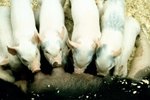A gilt pig is a female under the age of 1 year. Generally, the term refers to a pig who has not farrowed, or given birth to a litter. However, the age definition is more widely accepted than whether or not the pig has given birth to her initial litter. Once a pig has had a litter and is past her first year, she is called a sow.
Pig Life Stages
Newborn pigs, or piglets, are weaned between the ages of 8 to 10 weeks. The gilt's male equivalent is the boar, the term for an intact male pig. A barrow is a castrated male pig, a procedure generally done when the animal is just a few days old, and definitely by the age of 2 weeks. Barrows are destined for market, and the United States swine market doesn't permit "mass marketing of uncastrated male pigs," according to the American Veterinary Medical Association.
First Breeding
Gilts shouldn't be bred until they weigh between 300 and 350 pounds. For most breeds, that's about 7 or 8 months of age. If a gilt breeds too early, she might not reach her full size and her litters may be small. Let the gilt go through one estrus cycle before her first breeding. After breeding, the pregnant gilt should give birth three months, three weeks and three days later, for an approximately 114-day gestation period.
References
Photo Credits
-
taxzi/iStock/Getty Images
Writer Bio
Jane Meggitt has been a writer for more than 20 years. In addition to reporting for a major newspaper chain, she has been published in "Horse News," "Suburban Classic," "Hoof Beats," "Equine Journal" and other publications. She has a Bachelor of Arts in English from New York University and an Associate of Arts from the American Academy of Dramatics Arts, New York City.




